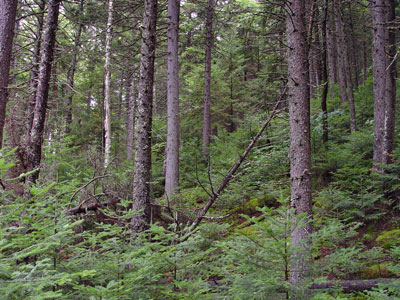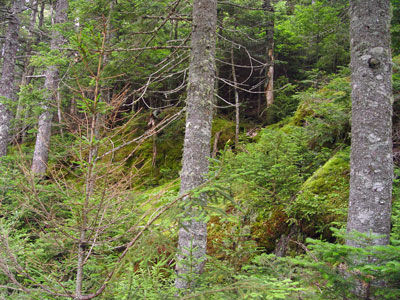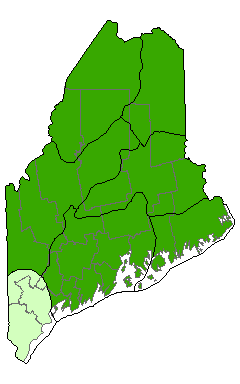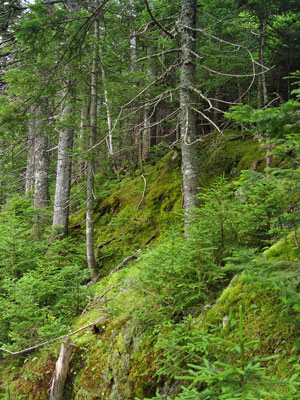DACF Home → Bureaus & Programs → Maine Natural Areas Program → Communities, Plants, and Animals → Natural Community Fact Sheets → Montane Spruce - Fir Forest
Printer Friendly Fact Sheet - 790 KB pdf (Get a free copy of Adobe Acrobat Reader)
Montane Spruce - Fir Forest
Scientific Name: Spruce - Fir - Wood-sorrel - Feather-moss Forest; State Rank: S5

- Community Description
- Soil and Site Characteristics
- Diagnostics
- Similar Types
- Conservation, Wildlife and Management Considerations
- Distribution
- Characteristic Plants
- Associated Rare Plants
- Associated Rare Animals
- Examples on Conservation Lands You Can Visit
Community Description: These closed canopy or sometimes patchy canopy forests are dominated by red spruce (50-95% cover); fir is a common associate (up to 35% cover) in younger stands and in canopy gaps, and yellow birch is the most common hardwood. Other conifers (northern white cedar, hemlock, or white pine) occasionally reduce the spruce dominance to as low as 40% cover. Striped maple is typical in the shrub layer, along with tree saplings. The herb layer is well developed (>15% cover, and often >30%), with tree regeneration and an assortment of herbs. Dwarf shrubs are conspicuously absent, except for a bit of velvet-leaf blueberry. Herbs reflect a boreal or montane component, with bluebead lily, northern wood-sorrel, and creeping snowberry locally abundant. Most of the ground surface is a lush mosaic of feather-mosses and leafy liverworts. Back to top.
Soil and Site Characteristics: These forests occur on cool and moist microsites at moderate elevations (600’-2500’, perhaps slightly higher), and north of 45 degrees latitude. Slopes are moderate to steep (5-50%), and usually north, west, or east facing. Soils are mostly well drained (some imperfectly drained), sandy to loamy, of moderate depth (25-50 cm), with pH 5.0-5.5. Back to top.

Diagnostics: Red spruce is dominant, and yellow birch is the most abundant hardwood. Herbaceous species exceed 15% cover, with montane/boreal herbs such as bluebead lily, northern wood-sorrel, creeping snowberry, mountain wood fern, and/or rose twisted stalk locally common. Byoids exceed 40% cover, with a large proportion of feather-mosses. Back to top.
Similar Types: Subalpine Fir Forests can share many species and often grade into this type as elevation decreases, but will have fir more abundant than spruce in the canopy, shorter trees, and canopy gaps more frequent. Lower-elevation Spruce - Fir Forests have similar canopies but much more depauperate herb and bryoid layers. They usually occur on somewhat drier sites and lack the assortment of montane/boreal herbs and the most common mosses will be broom-mosses rather than feather-mosses. Some Maritime Spruce - Fir Forests have a similar herb layer, but if so they have more canopy fir and occur along the immediate coast. Back to top.
Conservation, Wildlife and Management Considerations: This is the characteristic spruce - fir type of mountain slopes just below the subalpine zone, and it is extensively harvested and managed. Spruce budworm has impacted many sites as well, creating patchy forest structure. Some areas of high ecological quality, in the hundreds of acres, are known but not necessarily designated as areas reserved from harvesting. Almost all are within a landscape of managed forest rather than surrounded by land that has been permanently cleared and converted to other uses.
This community type may be utilized as nesting habitat by a number of coniferous forest specialist bird species, such as the sharp-shinned hawk, yellow-bellied flycatcher, bay-breasted warbler, Cape May warbler, blackpoll warbler, northern parula, blackburnian warbler, boreal chickadee, Swainson's thrush, red crossbill, white-winged crossbill, gray jay, and spruce grouse. Back to top.
Distribution: Western Maine westward (New England - Adirondack Province). Landscape Pattern: Large Patch, mostly as hundreds of acres. Back to top.


Characteristic Plants: These plants are frequently found in this community type. Those with an asterisk are often diagnostic of this community.
- Canopy
- Balsam fir*
- Black spruce*
- Yellow birch*
- Sapling/shrub
- Balsam fir*
- Red maple
- Striped maple
- Dwarf Shrub
- Velvet-leaf blueberry
- Herb
- Bluebead lily*
- Bunchberry
- Canada mayflower
- Creeping snowberry*
- Goldthread
- Northern wood-sorrel*
- Painted trillium
- Starflower
- Bryoid
- Common broom-moss*
- Mountain fern moss
- Red-stemmed moss
- Three-lobed bazzania
- Bicknell's thrush
Examples on Conservation Lands You Can Visit
| Example | County |
|---|---|
| Deboullie Ponds Public Lands | Aroostook Co. |
| Elephant Mountain, Appalachian Trail | Franklin Co. |
| Lower Horns Pond Trail, Bigelow Preserve | Franklin Co. |
| Traveler Mountain, Baxter State Park | Piscataquis Co. |
| Whitecap Mountain, Appalachian Trail | Piscataquis Co. |
